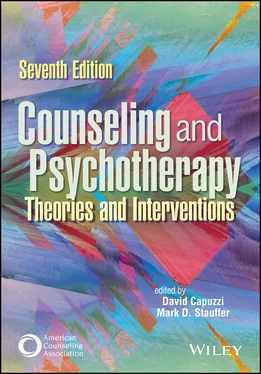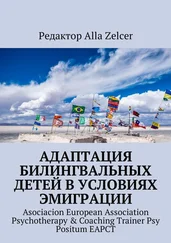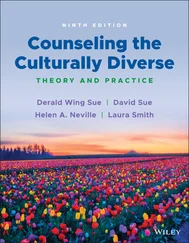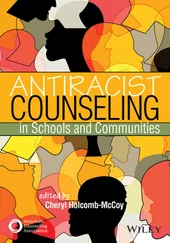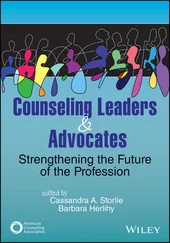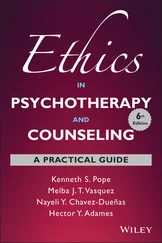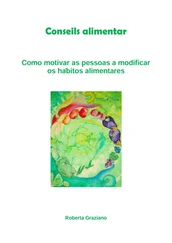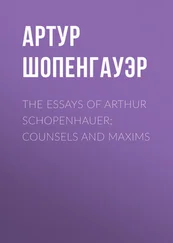Counseling and Psychotherapy
Здесь есть возможность читать онлайн «Counseling and Psychotherapy» — ознакомительный отрывок электронной книги совершенно бесплатно, а после прочтения отрывка купить полную версию. В некоторых случаях можно слушать аудио, скачать через торрент в формате fb2 и присутствует краткое содержание. Жанр: unrecognised, на английском языке. Описание произведения, (предисловие) а так же отзывы посетителей доступны на портале библиотеки ЛибКат.
- Название:Counseling and Psychotherapy
- Автор:
- Жанр:
- Год:неизвестен
- ISBN:нет данных
- Рейтинг книги:4 / 5. Голосов: 1
-
Избранное:Добавить в избранное
- Отзывы:
-
Ваша оценка:
- 80
- 1
- 2
- 3
- 4
- 5
Counseling and Psychotherapy: краткое содержание, описание и аннотация
Предлагаем к чтению аннотацию, описание, краткое содержание или предисловие (зависит от того, что написал сам автор книги «Counseling and Psychotherapy»). Если вы не нашли необходимую информацию о книге — напишите в комментариях, мы постараемся отыскать её.
Counseling and Psychotherapy — читать онлайн ознакомительный отрывок
Ниже представлен текст книги, разбитый по страницам. Система сохранения места последней прочитанной страницы, позволяет с удобством читать онлайн бесплатно книгу «Counseling and Psychotherapy», без необходимости каждый раз заново искать на чём Вы остановились. Поставьте закладку, и сможете в любой момент перейти на страницу, на которой закончили чтение.
Интервал:
Закладка:
Goal 3: Conceptualizing Connections, Disconnections, and Strategies for Survival
According to RCT, people are all born with an innate desire to form and sustain connections, and yet disconnections are a natural part of life. Whether disconnections are acute, chronic, or traumatic, despite people’s desire for connection, they may behave in ways that keep them out of the relationships they so badly want. Clarita is experiencing depression, chronic disconnection, and acute loneliness. She feels unworthy and hopeless. Her love for her children sustains her, and she feels tremendous guilt over her inability to care for them adequately.
The counselor would need to respect Clarita’s strategies for disconnection as they arise. She would need to remain humble in knowing that Clarita needs the time and has the wisdom to move at a pace that makes sense to her. During those times when Clarita is unable to sustain connection with the counselor, the counselor would honor that strategy, recognizing it as one born for survival.
Goal 4: Creating Mutuality and Connection in Counseling to Foster the Five Good Things
Clarita is disconnected from her family and their love and support. She is disconnected from her familiar home, and she feels lonely and overwhelmed. Counseling would involve authentically being with Clarita in her pain and cocreating a space where she could experience the five good things. This would involve creating a counseling climate in which Clarita can feel energy from the connection with the counselor, clarity in their work together, and an increased sense of self-worth because she feels seen and valued. Over time, the hope would be that Clarita would feel a desire to increase connections with others and to be moved to act (Jordan, 2018).
Working from an RCT perspective would not preclude asking questions about suicide and developing a collaborative safety plan. Using relational ethics as a framework, the counselor and Clarita would determine what is in her best interest and collaboratively make decisions about suicide prevention as needed. If Clarita were to be in danger, the counselor would take the time needed to help Clarita find safety and would stay connected to her throughout the process.
Summary
Through this case study, one can see how the crises and traumas in Clarita’s life are relationally situated. The hope for healing is also relationally situated. Clarita experienced the central relational paradox when she withdrew from relationships yet longed for them. Movement for Clarita may come by resolving the paradox through mutual empathy, supported vulnerability, and the emergence of a growth-fostering therapeutic relationship. An RCT-focused counselor works from a place of sociocultural humility and awareness of the power differential inherent in the therapeutic relationship. The science of relational neurobiology informs Clarita’s counselor that a mutually empathic relationship will enliven the neural pathways of healing, which will open up possibilities for more complex relational connections (Banks, 2015).
REFERENCES
1 Alvarez, A., & Lazzari, M. (2016). Feminist mentoring and relational cultural theory. Affilia, 31(1), 41–54. https://doi.org/10.1177/0886109915612512
2 American Counseling Association. (2014). ACA code of ethics. https://www.counseling.org/resources/aca-code-of-ethics.pdf
3 Banks, A. (2006). Relational therapy for trauma. Journal of Trauma Practice, 5(1), 25–47. https://doi.org/10.1300/J189v05n01_03
4 Banks, A. (2011). Developing the capacity to connect. Zygon, 46(1), 168–182. https://doi.org/10.1111/j.1467-9744.2010.01164.x
5 Banks, A. (2015). Four ways to click. Allen & Unwin.
6 Birrell, P. J., & Bruns, C. M. (2016). Ethics and relationship: From risk management to relational engagement. Journal of Counseling & Development, 94(4), 391–397. https://doi.org/10.1002/jcad.12097
7 Brown, B. (2015). Daring greatly: How the courage to be vulnerable transforms the way we live. Gotham Books.
8 Brown, E., Ramrakhiani, S., & Tate, K. (2020). Not a problem to be fixed: Successful first‐generation graduates and implications for college counselors. Journal of Multicultural Counseling and Development, 48(4), 243–256. https://doi.org/10.1002/jmcd.12197
9 Comstock, D. L., Hammer, T. R., Strentzsch, J., Cannon, K., Parsons, J., & Salazar, G. (2008). Relational-cultural theory: A framework for bridging relational, multicultural, and social justice competencies. Journal of Counseling & Development, 86(3), 279–287. https://doi.org/10.1002/j.1556-6678.2008.tb00510.x
10 Crumb, L., & Haskins, N. (2017). An integrative approach: Relational cultural theory and cognitive behavior therapy in college counseling. Journal of College Counseling, 20(3), 263–277. https://doi.org/10.1002/jocc.12074
11 Dorn‐Medeiros, C., Christensen, J., Lértora, I., & Croffie, A. (2020). Relational strategies for teaching multicultural courses in counselor education. Journal of Multicultural Counseling and Development, 48(3), 149–160. https://doi.org/10.1002/jmcd.12174
12 Duffey, T., & Haberstroh, S. (2014). Developmental relational counseling: Applications for counseling men. Journal of Counseling & Development, 92(1), 104–113. https://doi.org/10.1002/j.1556-6676.2014.00136.x
13 Duffey, T., Haberstroh, S., & Trepal, H. (2020). Creative approaches in counseling and psychotherapy. In D. Capuzzi & M. D. Stauffer (Eds.), Counseling and psychotherapy: Theories and interventions (6th ed., pp. 445–468). American Counseling Association.
14 Duffey, T., & Haberstroh, S. (2020). Introduction to crisis and trauma counseling. American Counseling Association.
15 Duffey, T., Haberstroh, S., Ciepcielinski, E., & Gonzales, C. (2016). Relational-cultural theory and supervision: Evaluating developmental relational counseling. Journal of Counseling & Development, 94(4), 405–414. https://doi.org/10.1002/jcad.12099
16 Duffey, T., & Kerl-McClain, S. (2008). History of the association for creativity in counseling. Journal of Creativity in Mental Health, 2(3), 61–70. https://doi.org/10.1300/J456v02n03_06
17 Flores, C., & Sheely‐Moore, A. (2020). Relational‐cultural theory–based interventions with LGBTQ college students. Journal of College Counseling, 23(1), 71–84. https://doi.org/10.1002/jocc.12150
18 Genero, N. P., Miller, J. B., Surrey, J., & Baldwin, L. M. (1992). Measuring perceived mutuality in close relationships: Validation of the Mutual Psychological Development Questionnaire. Journal of Family Psychology, 6(1), 36–48. https://doi.org/10.1037/0893-3200.6.1.36
19 Haberstroh, S., Duffey, T., & Hammer, T. (2020). Crisis and trauma counseling in social and cultural contexts. In T. Duffey & S. Haberstroh, (Eds.), Introduction to crisis and trauma counseling (pp. 45–70). American Counseling Association.
20 Hall, B., Harper, I., & Korcuska, J. (2018). Exploring a relational cultural group trainee model for master’s level counseling students. The Journal for Specialists in Group Work, 43(1), 81–104. https://doi.org/10.1080/01933922.2017.1411410
21 Hall, K., Garland, A., Charlton, G., & Johnson, M. (2018). Military culture and the civilian therapist: Using relational-cultural theory to promote the therapeutic alliance. Journal of Creativity in Mental Health, 13(4), 451–466. https://doi.org/10.1080/15401383.2018.1470951
22 Hammer, T., Crethar, H., & Cannon, K. (2016). Convergence of identities through the lens of relational-cultural theory. Journal of Creativity in Mental Health, 11(2), 126–141. https://doi.org/10.1080/15401383.2016.1181596
23 Hartling, L., & Lindner, E. (2016). Healing humiliation: From reaction to creative action. Journal of Counseling & Development, 94(4), 383–390. https://doi.org/10.1002/jcad.12096
Читать дальшеИнтервал:
Закладка:
Похожие книги на «Counseling and Psychotherapy»
Представляем Вашему вниманию похожие книги на «Counseling and Psychotherapy» списком для выбора. Мы отобрали схожую по названию и смыслу литературу в надежде предоставить читателям больше вариантов отыскать новые, интересные, ещё непрочитанные произведения.
Обсуждение, отзывы о книге «Counseling and Psychotherapy» и просто собственные мнения читателей. Оставьте ваши комментарии, напишите, что Вы думаете о произведении, его смысле или главных героях. Укажите что конкретно понравилось, а что нет, и почему Вы так считаете.
